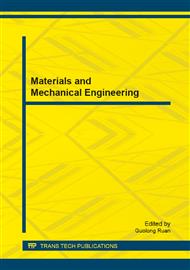[1]
O. Drubel, Future challenges within numerical field calculation in industrial machine development in the power range from 200 kW to 200 MW, Proc. 6th Int. Conference on Computational Electromagnetics (CEM'2006), Aachen, Germany (April 2006) 1-3.
Google Scholar
[2]
M.G. Pantelyat, A.N. Saphonov, N.G. Shulzhenko, Finite element analysis of the electromagnetic field in synchronous turbogenerator rotor slot wedges, Proc. 14th Int. IGTE Symposium on Numerical Field Calculation in Electrical Engineering, Graz, Austria (September 2010) 76-80.
DOI: 10.1049/cp.2011.0039
Google Scholar
[3]
M.G. Pantelyat, N.G. Shulzhenko, Finite element analysis of electromagnetic field and losses in a turbogenerator rotor, Proc. 6th Int. Conference on Computational Electromagnetics (CEM'2006), Aachen, Germany (April 2006) 151-152.
DOI: 10.1049/cp.2011.0039
Google Scholar
[4]
O. Drubel, Die Berechnung der elektromagnetischen und thermischen Beanspruchung von Turbogeneratoren während elektrischer Störfälle mittels Finiter-Differenzen-Zeitschritt-Methode, Electrical Engineering, 82 (2000) 327-338.
DOI: 10.1007/s002020000041
Google Scholar
[5]
P. Kisielewski, L. Antal, Transient currents in turbogenerator for the sudden short circuit, Prace Naukowe Instytutu Maszyn, Napędόw i Pomiarόw Elektrycznych Politechniki Wroclawskiej 63 (2009) 11.
Google Scholar
[6]
M. Tari, K. Yoshida, S. Sekito, R. Brütsch, J. Allison, A. Lutz, HTC Insulation technology drives rapid progress of indirect-cooled turbo generator unit capacity, IEEE PES Summer Meeting, Vancouver, Canada (July 2001) 6.
DOI: 10.1109/pess.2001.970285
Google Scholar
[7]
O. Bíró, K. Preis, On the use of the magnetic vector potential in the finite element analysis of three-dimensional eddy currents, IEEE Trans. Magn. 25 (1989) 3145-3159.
DOI: 10.1109/20.34388
Google Scholar
[8]
J.P. Holman, Heat Transfer, McGraw-Hill, New York, (2002).
Google Scholar
[9]
E.G. Kasharsky, N.B. Chemodanova, A.S. Shapiro, Losses and Heating in Massive Rotors of Synchronous Machines, Nauka, Leningrad, 1968 (in Russian).
Google Scholar
[10]
M.G. Pantelyat, Coupled electromagnetic, thermal and elastic-plastic simulation of multi-impulse inductive heating, International Journal of Applied Electromagnetics and Mechanics 9 (1998) 11-24.
DOI: 10.3233/jaem-1998-088
Google Scholar


